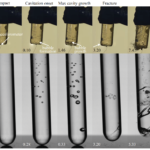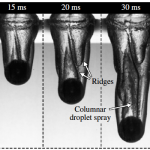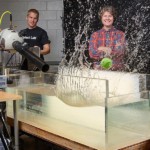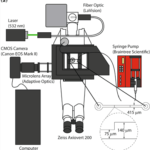Abstract:
Droplets on fibers are part of our everyday lives. Many phenomena involve drops and fibers such as the formation of dew droplets on a spiderweb, the trapping of water droplets on cactus spines or the motion of droplets on wetted moss hairs. These topics have been widely studied. In particular, Lorenceau \textit{et al.} \footnote{Lorenceau \'{E}, Clanet C, Qu\'{e}r\'{e} D (2004) Capturing drops with a thin fiber. \textit{Journal of colloid and interface science} 279(1):192–197} determined the critical volume of a water droplet hanging on a horizontal fiber. Here, we address a similar question : we try to find out the maximum droplet size on bent fibers, which are able to hold significantly more water than horizontal fibers. Indeed, we noticed that, in nature, some specific plants can hold large rain droplets thanks to their Y-shaped leaves. We try to mimic these structures with nylon fibers, of different diameters, bent with various angles. For each set-up, the critical water volume is determined. Finally, we propose models of the physics involved in determining droplet size that could be implemented in future fiber-based microfluidic devices.






Recent Comments